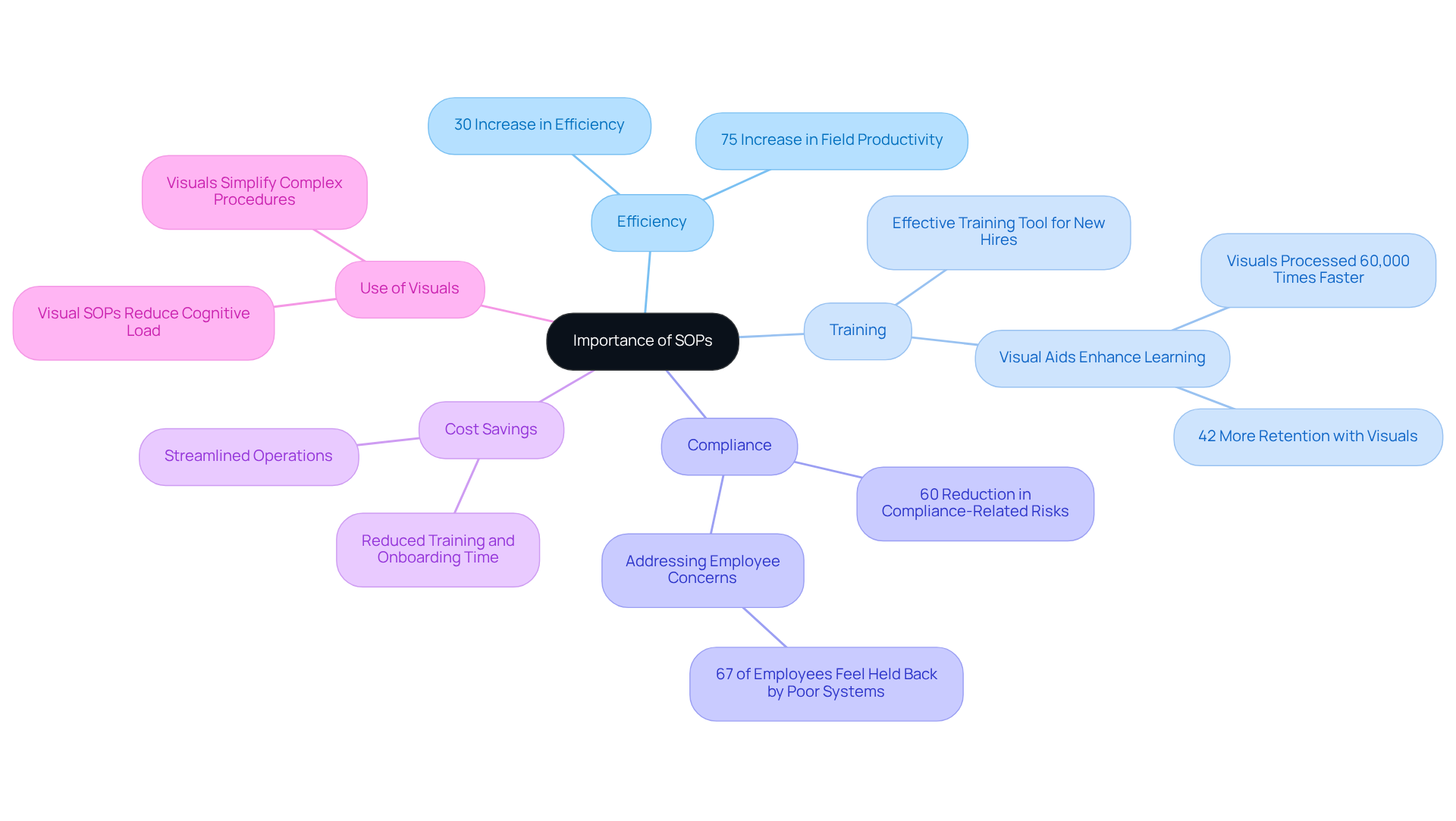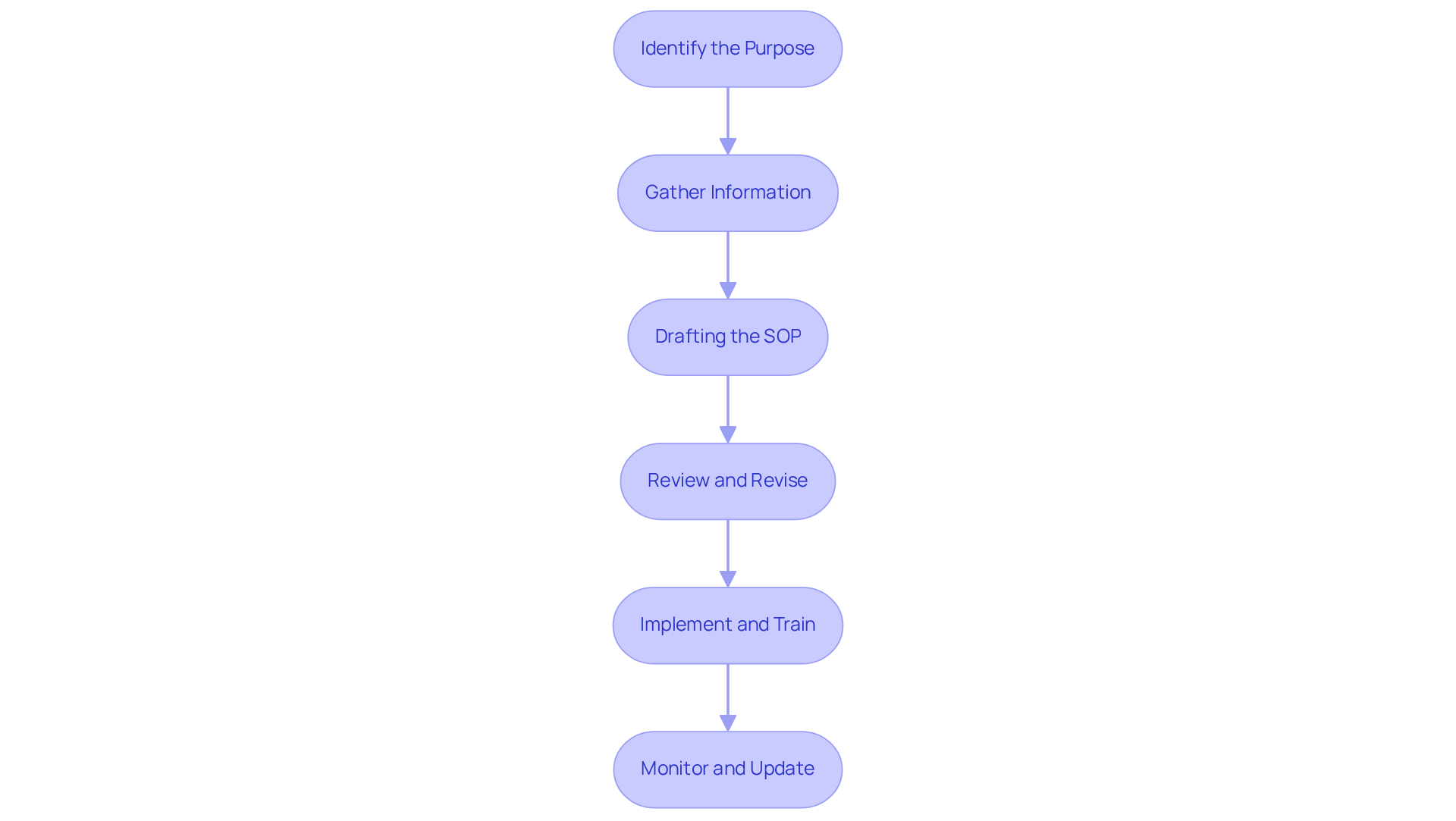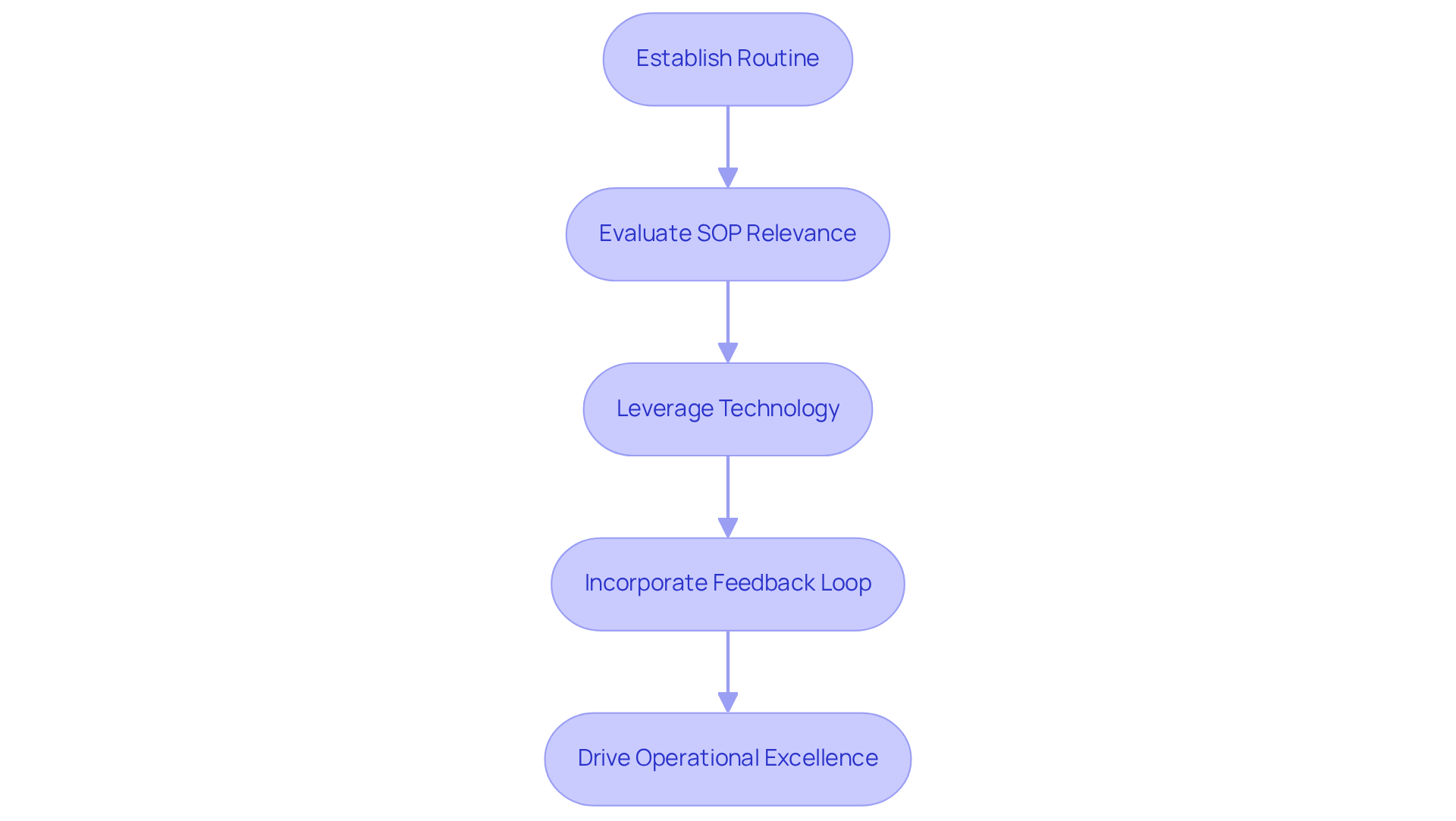
Process Improvement through Documentation
|
October 17, 2025
|
10 SOP Best Practices for Operations Managers to Enhance Efficiency
Overview
Hey there! You might be wondering how to boost your efficiency as an operations manager. Well, this article shares 10 best practices that can help you do just that through the smart implementation of Standard Operating Procedures (SOPs). Did you know that having well-defined SOPs can ramp up your operational efficiency by as much as 30%? Plus, they can cut compliance-related risks by up to 60%! That’s a big deal, right?
Now, let’s dive into why structured SOP development and engaging your stakeholders are game-changers. When you streamline your operations, you not only save time but also money. It’s all about making your processes smoother and more effective. So, if you’re ready to enhance your operations, keep reading to discover how these practices can transform your workflow and lead to some serious cost savings.
Key Highlights:
- Implementing SOPs provides clear guidance, reducing the risk of mistakes and ensuring consistency in task execution.
- Organisations with well-defined SOPs can experience up to a 30% increase in efficiency.
- Effective SOPs can lead to significant cost savings by streamlining operations and reducing training time.
- Compliance-related risks can be reduced by as much as 60% through efficient SOPs.
- Incorporating visual aids in SOPs enhances understanding and caters to diverse learning styles.
- A structured approach to SOP development includes identifying purpose, gathering information, drafting, reviewing, training, and monitoring.
- Engaging stakeholders in SOP development ensures practical and effective procedures, fostering ownership and compliance.
- Regular reviews and updates of SOPs, ideally every six months to a year, maintain their relevance and effectiveness.
- Utilising documentation management software can streamline the SOP updating process and improve accessibility.
Introduction
You might be wondering, what exactly are Standard Operating Procedures (SOPs) and why should you care? Well, they’re really the backbone of operational efficiency, acting as a roadmap to help organizations streamline processes and boost performance. When operations managers implement effective SOPs, they can unlock a treasure trove of benefits—think increased efficiency, fewer errors, and better compliance.
But here’s the catch: it’s not just about creating these procedures; it’s also about keeping them relevant and effective over time. So, how can you navigate this tricky landscape to really maximize your SOPs and cultivate a culture of continuous improvement? Let’s dive in and explore!
Understand the Importance of Standard Operating Procedures (SOPs)
You might be wondering why the implementation of [10 SOP](https://sowflow.io) is so crucial for organizations striving for high efficiency and quality. Well, they provide clear, step-by-step guidance through a 10 SOP that helps employees perform tasks consistently, which in turn significantly reduces the risk of mistakes. Plus, the 10 SOP serve as fantastic training tools for new hires, ensuring everyone is on the same page from the start.
Speaking of efficiency, did you know that organizations with well-defined 10 SOPs report a whopping 30% increase in efficiency? That's right! And it doesn’t stop there—effective 10 SOP can lead to significant cost savings by streamlining operations and reducing training and onboarding time. For instance, when a management control system was implemented in oil palm plantations, they saw an 11% boost in daily tonnage harvested and a staggering 75% increase in field productivity. Talk about operational success!
Now, let’s not overlook the importance of compliance with the 10 SOP. Efficient 10 SOP can reduce compliance-related risks by as much as 60%, which really underscores their importance in maintaining quality and consistency. With 67% of employees feeling that poor systems hold them back, it’s clear that implementing effective 10 SOP is essential to address these issues.
And here’s a little tip: incorporating visual aids in your SOPs can make a world of difference! Visuals are processed about 60,000 times faster than text, which caters to various learning styles and boosts overall operational effectiveness. So, why not give it a shot and see how it transforms your documentation?

Follow a Structured Process for SOP Development
Creating effective 10 SOP can feel daunting, right? But don’t worry! Operations managers can follow a structured approach that makes the process smoother. Let’s break it down step by step.
- Identify the Purpose. You’ll want to clearly articulate the objectives of the SOP, making sure they align with your organizational goals.
- Gather Information. Collect relevant data from existing documentation and chat with team members who actually execute the tasks. Their practical insights can be a goldmine!
- Drafting the SOP. Use clear and concise language, breaking down each task into sequential steps. This makes it easier for everyone to understand. And here’s a little tip: with SowFlow's instant documentation solution, managers can craft user guides effortlessly, summoning the wisdom of existing documentation with just a command. How cool is that?
- Review and Revise. Engage stakeholders in the evaluation process to ensure accuracy and completeness. This collaborative environment not only improves the SOP but also strengthens team dynamics. Plus, with SowFlow, updating and revising documentation becomes seamless, keeping your standard operating procedures relevant in our ever-changing business world.
- Implement and Train. Conduct training sessions to ensure everyone understands the SOP and can follow it effectively.
- Monitor and Update. Regularly evaluate the SOP to keep it relevant and effective, adjusting as needed for any changes in procedures or regulations.
This structured method not only boosts the quality of your 10 SOP but also promotes a culture of ongoing improvement within your organization. In the end, this leads to greater operational efficiency and fewer errors. So, are you ready to dive in and enhance your documentation process?

Engage Stakeholders for Effective SOP Implementation
You might be wondering why involving stakeholders during the 10 sop development phase is so crucial. Well, it’s all about ensuring the 10 sop procedures are practical and effective! Operations managers should definitely include team members who will actually be using the 10 sop, along with supervisors and other relevant staff. This partnership can bring in valuable insights about the real activities and challenges faced in practice. Plus, regular feedback sessions can really help refine the 10 sop, making sure they’re user-friendly. And let’s not forget, engaging stakeholders in the 10 sop fosters a sense of ownership and responsibility, which can lead to higher compliance rates and smoother execution.
Now, let’s dive into how tools like SowFlow can make this process even better. As Anastasia Masadi, a Product Owner, puts it, "SowFlow has transformed the way we document work and deliver to our clients. I can develop standard operating procedures and training materials without taking separate screenshots or leaving the browser, saving me valuable time." This really shows how SowFlow enables teams to quickly create 10 sop, boosting documentation efficiency and simplifying the overall workflow. Isn’t that something worth exploring?

Establish a Routine for Reviewing and Updating SOPs
You might be wondering how to keep your 10 SOP effective. Well, operations managers need a solid routine to review and update the 10 SOP regularly. The best practice is to check in every six months to a year, tailoring it to the specific procedures you’re working with. During these assessments, it’s crucial to evaluate the relevance of the 10 SOP, gather feedback from users, and make necessary adjustments to reflect any changes in procedures or regulations. Organizations that make regular updates a priority not only maintain high-quality standards but also create a culture of continuous improvement.
Now, let’s talk tech! Leveraging technology can really streamline this process. For instance, using documentation management software helps you track changes and ensures that everyone has access to the latest versions of your SOPs. Take a legal firm that went digital and set up a centralized management system—it cut their document retrieval time by 50% and reduced storage costs by 20%! Similarly, organizations like NGC Group, which embraced SmartPM, saw significant improvements in scheduling and project health in just four months.
But wait, there’s more! Incorporating a feedback loop is just as important. It allows employees to flag unclear steps or suggest improvements, making sure that your SOPs evolve with the organization’s needs. By weaving these practices into your operations, you can keep the 10 SOPs relevant, compliant, and effective, ultimately driving operational excellence. So, what are you waiting for? Let’s get started on making your documentation work for you!

Conclusion
Implementing effective Standard Operating Procedures (SOPs) is crucial for organizations looking to achieve operational excellence. You might be wondering how exactly SOPs help—well, they provide clear, structured guidance that enhances consistency, reduces errors, and fosters a culture of continuous improvement. The perks of well-defined SOPs go beyond just compliance; they can lead to significant boosts in efficiency and substantial cost savings, making them a vital part of any successful operational strategy.
Throughout this article, we’ve shared some key insights on how to develop and implement SOPs effectively. A structured approach to creating SOPs—starting with:
- Identifying objectives
- Gathering info
- Drafting
- Reviewing
- Training
ensures that the procedures are practical and user-friendly. Engaging stakeholders in this process not only improves the quality of the SOPs but also promotes buy-in, leading to better compliance and smoother execution. And don’t forget, regularly reviewing and updating SOPs is just as important; it helps organizations adapt to changes and maintain high standards of quality.
In summary, adopting best practices for SOP development and implementation can really boost organizational efficiency. So, operations managers, it’s time to prioritize the creation and maintenance of SOPs! Leverage technology and engage your stakeholders to enhance their effectiveness. By doing this, organizations can streamline their processes and cultivate a resilient, adaptable workforce ready to tackle future challenges. Embracing these practices isn’t just a step toward operational excellence; it’s a commitment to continuous growth and improvement.
Frequently Asked Questions
What are Standard Operating Procedures (SOPs) and why are they important?
SOPs are clear, step-by-step guidelines that help employees perform tasks consistently, reducing the risk of mistakes. They are crucial for organizations aiming for high efficiency and quality.
How do SOPs impact organizational efficiency?
Organizations with well-defined SOPs report a 30% increase in efficiency, as they streamline operations and improve consistency in task performance.
Can SOPs lead to cost savings?
Yes, effective SOPs can lead to significant cost savings by reducing training and onboarding time, as well as improving overall operational efficiency.
What are some examples of the benefits of implementing SOPs?
An example includes a management control system implemented in oil palm plantations, which resulted in an 11% increase in daily tonnage harvested and a 75% increase in field productivity.
How do SOPs affect compliance and risk management?
Efficient SOPs can reduce compliance-related risks by up to 60%, highlighting their importance in maintaining quality and consistency within organizations.
What do employees think about poor systems in relation to SOPs?
About 67% of employees feel that poor systems hinder their performance, indicating the need for effective SOPs to address these issues.
How can visual aids enhance SOPs?
Incorporating visual aids in SOPs can significantly improve understanding, as visuals are processed 60,000 times faster than text, catering to various learning styles and boosting operational effectiveness.
👍
What others are liking
5 Steps to outline your ideal documentation structure
5 MINS READ
Where to start the your journey of mapping out your ideal documentation structure, aligning it with the very heartbeat of your organization?
Defining a winning level of detail in your process
3 MINS READ
What is too much detail, and what is too little? This article described in that winning level detail about what detail is enough.





